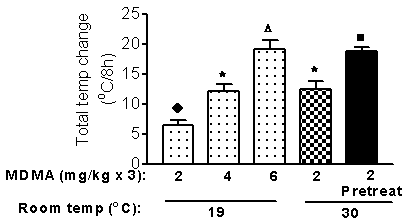| pA2
online © Copyright 2003 The British Pharmacological Society |
048P
University
of Manchester Autumn Meeting September 2003 |
|
Effect of ambient temperature and 3,4-methylenedioxymethamphetamine (MDMA) pretreatment on the hyperthermic response of rats to repeated low doses of MDMA
|
Print Abstract Search PubMed
for: |
MDMA administration can produce acute hyperthermia in rats (Mechan et al., 2002) and humans (Henry, 1992). Since humans ingesting MDMA recreationally often do so in crowded, high ambient temperature conditions, we examined the response of rats to a repeated (x 3) dose protocol of MDMA, in order to mimic human "binge" dosing, when they were housed in normal and raised ambient conditions. We also examined the effect of a prior neurotoxic dose of MDMA (12.5 mg kg-1; Mechan et al., 2001) on their response to this dosing regime.
Adult
male Dark Agouti rats (![]() 180
g at start of study) were injected with saline or MDMA (2, 4 or 6 mg kg-1
i.p.) 3 times at 3 h intervals when housed at 19o
C. Rectal temperature was measured with a probe. In another
experiment rats were administered with either a neurotoxic dose of MDMA
(12.5 mg kg-1 i.p.) or saline when housed
at 19o C and 4 weeks later placed in
a room kept at 30o C. Sixty min later
both groups were divided into 2 with the sub-groups injected with saline
or MDMA (2 mg kg-1 i.p. x 3) and rectal
temperature measured over the next 8 h. The mean rectal temperature of
the saline-injected control group at each time point was subtracted from
each MDMA-treated rat. Addition of the temperature change at every time
point for each individual animal allowed calculation of the total temperature
change over 8 h; giving a total area under the temperature curve (AUC)
and thereby allowing comparison of the size of the response in each group.
180
g at start of study) were injected with saline or MDMA (2, 4 or 6 mg kg-1
i.p.) 3 times at 3 h intervals when housed at 19o
C. Rectal temperature was measured with a probe. In another
experiment rats were administered with either a neurotoxic dose of MDMA
(12.5 mg kg-1 i.p.) or saline when housed
at 19o C and 4 weeks later placed in
a room kept at 30o C. Sixty min later
both groups were divided into 2 with the sub-groups injected with saline
or MDMA (2 mg kg-1 i.p. x 3) and rectal
temperature measured over the next 8 h. The mean rectal temperature of
the saline-injected control group at each time point was subtracted from
each MDMA-treated rat. Addition of the temperature change at every time
point for each individual animal allowed calculation of the total temperature
change over 8 h; giving a total area under the temperature curve (AUC)
and thereby allowing comparison of the size of the response in each group.
MDMA (2- 6 mg kg -1 i.p) dose-dependently increased the total increase in rectal temperature (Fig). A repeated dose of 2 mg kg-1 x3 given to rats housed at 30o C produced a similar total increase in rectal temperature to that seen with twice the dose administered to rats at normal ambient temperature (Fig). Administration of MDMA (2 mg kg-1 x 3) to rats given a prior neurotoxic dose of MDMA produced a hyperthermic response which was greater than that seen in non-pretreated rats (Fig).

Fig.
AUC rectal temp response following MDMA in rats housed at 19o
C or 30o C. 'Pretreat' means
prior neurotoxic dose of MDMA. ![]() :
Diff. from control, p<0.05;
:
Diff. from control, p<0.05;![]() :
Diff. from 2 mg kg-1, p<0.05;
:
Diff. from 2 mg kg-1, p<0.05; ![]() :
Diff. from 2 & 4 mg kg-1, p<0.01;
:
Diff. from 2 & 4 mg kg-1, p<0.01;
![]() : Diff. from 2 &
4 mg kg-1 at 19oC
and 2 mg kg-1 at 30o
C, p<0.01 (ANOVA plus Bonferroni correction for 't' test).
: Diff. from 2 &
4 mg kg-1 at 19oC
and 2 mg kg-1 at 30o
C, p<0.01 (ANOVA plus Bonferroni correction for 't' test).
These data suggest that repeated low doses of MDMA produce a greater overall hyperthermic response in rats housed at 30o C than those housed at 19o C and support and extend our observation that a neurotoxic dose of MDMA impairs thermoregulation in rats, with a failure of the animals to lose body temperature when housed at high ambient temperature (Mechan et al., 2001; Green et al., 2003).
Henry, J.A. (1992) Br. Med. J., 305: 5-6.
Green, A.R. et al. (2003) Br. J. Pharmacol.138: 196P.
Mechan, A.O. et al. (2001) Psychopharmacology, 155:
413-418.
Mechan, A.O. et al. (2002) Br. J. Pharmacol, 135:
170-180.